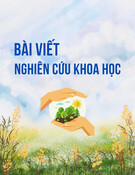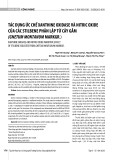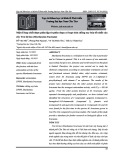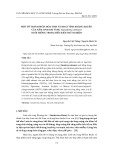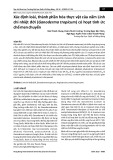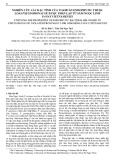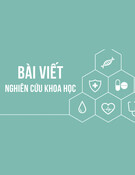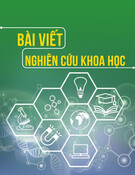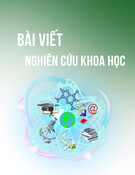
116 Nong Lam University, Ho Chi Minh City
The Journal of Agriculture and Development 23(Special issue 1) www.jad.hcmuaf.edu.vn
Antifungal activity of mangosteen pericarp and cashew leaf extract against
Fusarium oxysporum in vitro
Nhi N. Y. Nguyen2, Vinh D. H Nguyen1,2, Dong N. T. Le1, & Ly T. P. Trinh1,2*
1Research Institute for Biotechnology and Environment, Nong Lam University, Ho Chi Minh City, Vietnam
2Faculty of Biological Sciences, Nong Lam University, Ho Chi Minh City, Vietnam.
ARTICLE INFO ABSTRACT
Research Paper
Received: August 16, 2024
Revised: October 08, 2024
Accepted: October 10, 2024
Keywords
Antifungal activity
Cashew leaves
Fusarium oxysporum
Mangosteen pericarp
Phenolic compounds
*Corresponding author
Trinh Thi Phi Ly
Email:
phily@hcmuaf.edu.vn
Polyphenols are secondary compounds that occur widely in
plants and are highly effective in controlling plant pathogenic
microorganisms. This study aimed to screen polyphenolic-rich plant
extracts for their antifungal potential against Fusarium oxysporum.
Several plant materials including cashew leaves, castor fruits, castor
leaves, coffee husks, giant milkweed leaves, mangosteen pericarps
and soapberry fruits were investigated for their total phenolic
content. The results showed that cashew leaves and mangosteen
pericarps contained high level of polyphenols at 108.23 and
124.14 mg GAE/g, respectively. The main phenolic compounds
found in cashew leaves were gallic acid and protocatechuic acid
at 377.29 mg/100 g and 56.44 mg/100 g, respectively. Mangosteen
pericarps contained 16.22 mg/100 g protocatechuic acid and 55.75
mg/100 g of chlorogenic acid. The antifungal activity of cashew
leaf and mangosteen pericarp extracts against F. oxysporum was
32.92 - 77.08% and 68.33 - 83.75%, respectively at the extract
concentration from 2% to 10%. The combined use of cashew leaf
and mangosteen pericarp extracts exhibited an additive inhibition
against F. oxysporum. Cashew leaves and mangosteen pericarp are
potential materials for producing bio-fungicides, which are not
only effective but also safe for human and the environment.
Cited as: Nguyen, N. N. Y., Nguyen, V. D. H., Le, D. N. T., & Trinh, L. T. P. (2024). Antifungal
activity of mangosteen pericarp and cashew leaf extract against Fusarium oxysporum in
vitro. The Journal of Agriculture and Development 23(Special issue 1), 116-127.

Nong Lam University, Ho Chi Minh City 117
The Journal of Agriculture and Development 23(Special issue 1) www.jad.hcmuaf.edu.vn
2. Materials and Methods
2.1. Plant materials, chemicals and reagents
Raw materials including cashew leaves
(Anacardium occidentale L.), castor fruits and
leaves (Ricinus communis L.), coffee husks (Cof-
fea arabica L.), giant milkweed leaves (Calotrop-
is gigantea L.), mangosteen pericarps (Garcinia
mangostana L.) and soapberry fruits (Sapindus
saponaria L.) were collected in Ho Chi Minh
City, Binh Phuoc and Lam Dong province. The
sample was washed, drained naturally at room
temperature then dried at 50oC until the mois-
ture content reached below 13%. Then, they were
pulverized into fine powder, sieved through a
sifter with a pore size of 0.1 mm and stored in
zipper bags in desiccators at room temperature.
The fungal pathogen F. oxysporum f. sp. lycoper-
sici was provided by the Research Institute for
Biotechnology and Environment, Nong Lam
University, Ho Chi Minh City.
Gallic acid, chlorogenic acid and protocatechuic
acid were purchased from Sigma-Aldrich.
Acetonitrile and acetic acid (HPLC grade) were
supplied by Thermo Fisher Scientific. Folin-
Ciocalteau’s reagent was provided by Supelco. All
other chemicals were of analytical grade.
2.2. Determination total phenolic content
Plant extracts were prepared by mixing 1 g of
plant material with 70% aqueous ethanol with
a ratio of raw material to solvent of 1:10. The
extraction was conducted using ultrasonication
with a frequency of 20 kHz and power of 500 W for
15 min. Then, the extract was obtained by filtering
through filter papers (Whatman No.1). The residual
solid was extracted with 70% aqueous ethanol two
more times. The extracts were combined and made
up to a total volume of 50 mL.
1. Introduction
Fusarium oxysporum is a soil-borne pathogen
which causes Fusarium wilt disease on many
plant species such as banana, tomato, peas and
seriously affects crop yield by up to 80 - 90% (Ma
et al., 2013; Edel-Hermann & Lecomte, 2019).
Management of Fusarium wilt disease has been
a challenge for many years. Controlling plant
fungal diseases using chemical pesticides is
not a sustainable solution because of high cost,
increasing resistant strains, residual toxicity in
the food chains and the environment. Biological
control agents have gained much attention as
alternatives to synthetic chemicals due to their
effectiveness and safety (Muller-Riebau et al.,
1995). The use of crude plant extracts rich in
bioactive compounds has been approached
and applied widely in agricultural processes.
Polyphenols are secondary metabolites occurring
abundant in plants with antioxidant, antibacterial
and antifungal activities, which exhibit effective
inhibition against fungal pathogens (Yuan et
al., 2018). Phenolic compounds affect mycelial
growth by inhibiting spore reproduction,
disrupting cell membranes, and suppressing
the synthesis of important proteins or enzymes
(Oufensou et al., 2020). In our previous study,
antifungal activity was directly proportional
to the content of phenolic compounds in the
plant extracts (Nguyen et al., 2024). Among
locally available plant materials, cashew leaf and
mangosteen pericarp emerged as prominent
phenolic-rich sources, which were investigated
for their main constituents and inhibitory effect
on the growth of Fusarium oxysporum. The study
provided useful information for further research
and development of polyphenol-derived
bioproducts for effective control of Fusarium
oxysporum.

118 Nong Lam University, Ho Chi Minh City
The Journal of Agriculture and Development 23(Special issue 1) www.jad.hcmuaf.edu.vn
were determined by high performance liquid
chromatography (HPLC) with a diode array
detector (Agilent 1260 Infinity II, Santa Clara,
United States). A binary pump was set up with
mobile phase A (1% acetic acid in water) and
mobile phase B (1% acetic acid in acetonitrile).
A Poroshell 120-EC C18 reversed-phase column
(100 mm × 4.6 mm, particle size 2.7 μm) was
used for separation at a column temperature of
35°C. The mobile phase and elution program
are presented in Table 1. The sample injection
volume was 5 μL and the mobile phase was
injected at a flow rate of 1 mL/min. Gallic acid
and protocatechuic acid were detected at 270 nm;
chlorogenic acid was detected at 320 nm (Trinh
et al., 2018). Results were expressed in mg/100 g
of dry material.
Total phenolic content (TPC) was determined
by spectrophotometry according to the reaction
with Folin-Ciocalteu reagent (Trinh et al., 2018).
Briefly, 100 μL of the prepared extract was mixed
with 100 μL of Folin-Ciocalteu reagent. After
5 min, 300 μL of 20% Na2CO3 solution was
added to the mixture to stop the reaction prior
to making up to 5 mL with distilled water. The
mixture was incubated for 60 min in darkness at
room temperature. Its absorbance was measured
at 730 nm. Gallic acid was used as the standard
with a concentration range of 100 - 500 mg/L.
TPC was expressed as milligram gallic acid
equivalent per gram of dry matter (mg GAE/g).
2.3. Quantification of phenolic compounds in
plant extracts
Gallic acid (GA), protocatechuic acid (PCA)
and chlorogenic acid (CGA) in the extracts
Table 1. Elution program for separation of phenolic compounds
Time (min) % A % B
2 95 5
17 60 40
20 60 40
21 95 5
25 95 5
2.4. Inhibitory activity of plant extracts
against F. oxysporum in vitro
Fusarium oxysporum was inoculated on po-
tato dextrose agar (PDA) at 28 ± 2°C for seven
days. Then, a piece of mycelium with diameter
8 mm was placed on petri dishes (90 × 15 mm)
containing PDA medium and plant extracts.
Plant extracts at concentrations of 4, 8, 12, 16,
20% were prepared by extracting 4, 8, 12, 16, 20
g of dried plant material, respectively with 70%
ethanol using the procedure mentioned earlier
(section 2.2), then ethanol was removed by an
evaporator followed by the addition of distilled
water to make a total volume of 100 mL. The
plant extracts were mixed with 2X PDA medium
at the same volume to obtain a medium contain-
ing 2, 4, 6, 8, 10% plant extracts, respectively. The
extract combination of cashew leaves and man-
gosteen pericarps at 4% and 8% was prepared us-
ing 2% and 4% of each, respectively by the same
procedure used for the individual extracts.

Nong Lam University, Ho Chi Minh City 119
The Journal of Agriculture and Development 23(Special issue 1) www.jad.hcmuaf.edu.vn
2.6. Data analysis
Experimental results were expressed as mean
± standard error. One-way analysis of variance
and Tukey’s tests were used to determine
significant differences (P < 0.05) between the
means using the MiniTab 16.0 program.
3. Results and Discussion
3.1. Determination of total phenolic content
This study collected and screened locally
valuable plant materials with the aim to search
phenolic-rich sources, which are believed to
perform antifungal capacity. The total phenolic
content of collected samples was found in a wide
range of 7.45 - 124.14 mg GAE/g, indicating
the differences in the quantity of bioactive
compounds in plants (Table 2). Most notably,
cashew leaf and mangosteen pericarp contained
the highest phenolic levels at 108.23 and 124.14
mg GAE/g, respectively, which were much higher
than other samples.
Post-inoculation plates were incubated at 28
± 2°C. Mycelium growth was observed at day
1, 3, 5, and 7 after inoculation. Each treatment
was conducted in triplicate. The ability to inhib-
it fungi was evaluated by the following formula
(Chang et al., 2000):
Whereas I is antifungal index, D is diameter
of mycelium treated with the extracts, Dc is
mycelial diameter of the control without treated.
2.5. Observation of mycelial morphology
In this study, the morphological characteristics
of F. oxysporum mycelium were observed by
microscopic examination. A small piece of the F.
oxysporum was carefully collected and placed on
a clean microscope slide. Then, a drop of sterile
saline solution was added to the specimen prior
to covering it with a coverslip. Observations were
conducted using a microscope (Evident CX23)
equipped with 40X objectives (Buffi et al., 2023).
Table 2. Total phenolic content in plant extracts
Plant materials Total phenolic content
(mg GAE/g)
Coffee husks 10.06 ± 0.78
Soapberry fruits 7.45 ± 0.40
Mangosteen pericarps 124.14 ± 0.49
Castor fruits 14.78 ± 0.51
Castor leaves 14.02 ± 0.10
Giant milkweed leaves 10.08 ± 0.22
Cashew leaves 108.23 ± 0.85
Mangosteen pericarps have long been used as
a traditional folk medicine for sprains, typhoid,
diarrhea and skin infections. It has attracted much
attentions due to exhibiting anti-inflammatory,
antioxidant, antibacterial and antifungal activity
(Kaur et al., 2020). Mangosteen pericarp accounts
for about 65% of the total fresh weight of the
fruit, with a TPC of 140.66 mg GAE/g containing
many substances such as xanthones, phenolic
acids, flavonoids, and benzophenones (Rizaldy
et al., 2021). Vo & Nguyen (2023) reported that
mangosteen pericarp collected in Vietnam had

120 Nong Lam University, Ho Chi Minh City
The Journal of Agriculture and Development 23(Special issue 1) www.jad.hcmuaf.edu.vn
content and antimicrobial activity has been
demonstrated (Bouslamti et al., 2022). In our
previous study, antifungal activity of plant
extracts against Fusarium oxysporum was
observed to enhance with an increase in the
content of phenolic compounds (Nguyen et al.,
2024). Figure 1 and Figure 2 show the effect of
cashew leaf and mangosteen pericarp extracts on
the growth of F. oxysporum. The average diameter
of fungal colonies ranging from 53.67 to 18.33
mm corresponding to antifungal index ranging
from 32.92 to 77.08% was observed on PDA
medium supplemented with cashew leaf extracts
at 2 - 10% (material weight/total volume). The
mycelium didn’t spread normally in the medium
containing the cashew leaf extracts as compared
to the control. A decrease in fungal biomass was
observed at all extract concentrations and purple
color completely disappeared at 8% cashew leaf
extract. The antifungal activity of mangosteen
pericarp extract against F. oxysporum was higher
than that of cashew leaf extract with values
ranging from 68.33 to 83.75% at concentrations
of 2 - 10% (w/v). Mycelia didn’t spread onto
the medium supplemented with mangosteen
pericarp extracts and the particular purple color
wasn’t observed at all mangosteen pericarp
extract levels investigated.
high polyphenol content at 195.05 mg GAE/g and
showed antioxidant activity, inhibitory effect on
α-glucosidase enzyme and antibacterial capacity
against Propionibacterium acnes. Do et al. (2011)
isolated α-mangostin and γ-mangostin from the
alcohol extract of mangosteen pericarp, which
exhibited antioxidant activity and antibacterial
effect on Edwardsiella tarda. Cashew leaves
have shown the ability to inhibit pathogenic
microorganisms such as Staphylococcus aureus,
Streptococcus mutans, Escherichia coli, Candida
albicans, and Aspergillus niger (Shiekh et al., 2022).
Duangjan et al. (2019) reported TPC of cashew
leaves of 160.35 mg GAE/g with the presence
of flavonoids, tannins and anthocyanins. In this
study, mangosteen pericarps and cashew leaves,
which were the most abundant phenolic sources,
were investigated for their antifungal activity and
specific phenolic compounds.
3.2. Antifungal activity
Phenolic compounds are the most diverse
phytochemicals presenting in plants that have
been reported to show biological effects, such as
antibacterial, antifungal, antiviral, antioxidant,
and anti-inflammatory activities (Nguyen et
al., 2019, Soyel et al., 2022; Wang et al., 2022).
A strong correlation between total phenolic
Figure 1. Effect of cashew leaf extracts on F. oxysporum. A: Antifungal index; B: Mycelial growth
on the media supplemented with the extract at different concentrations (a-f) 2, 4, 6, 8, 10% and
control, respectively.
A B

